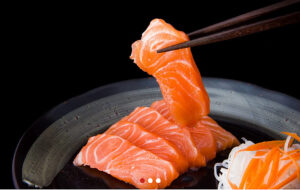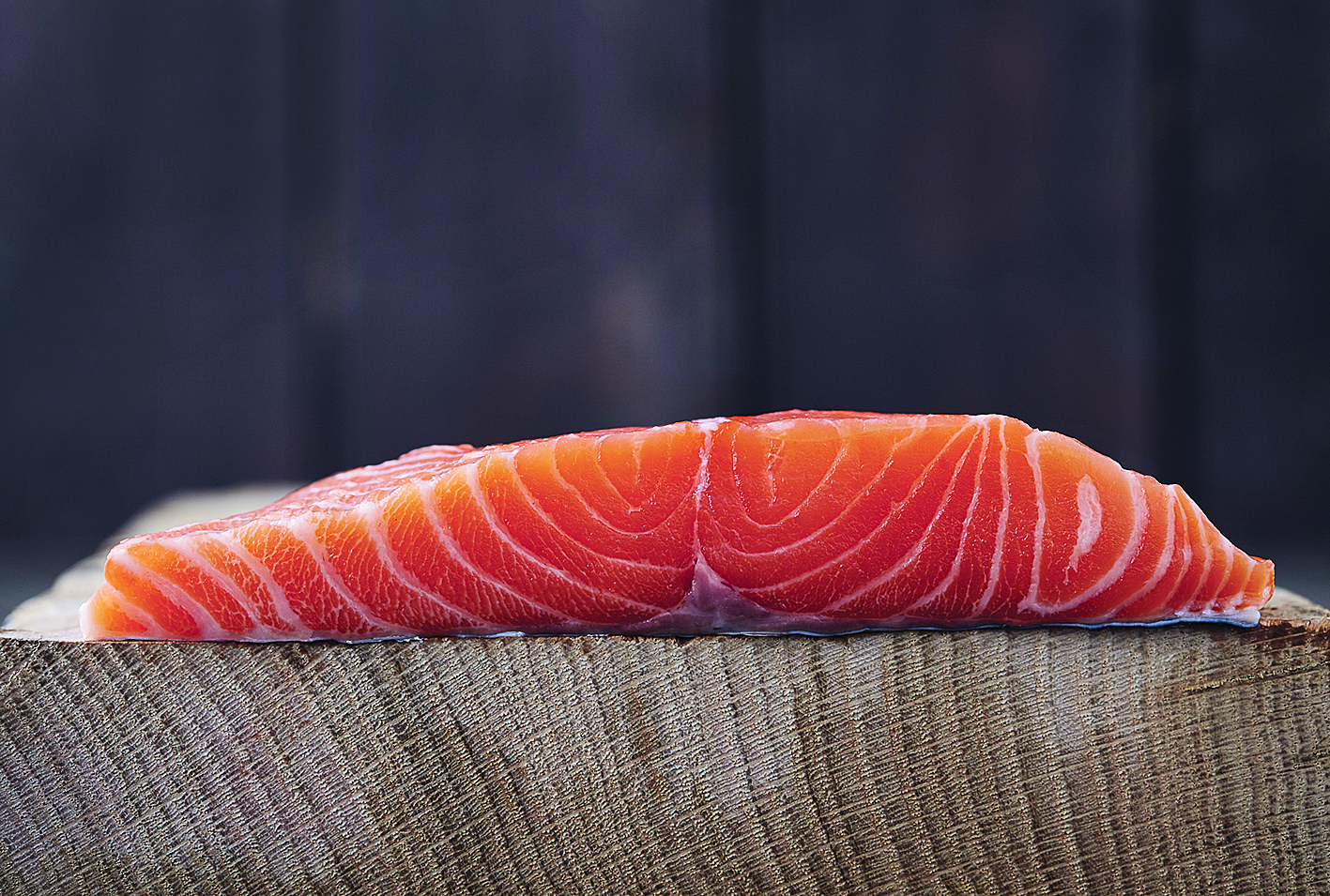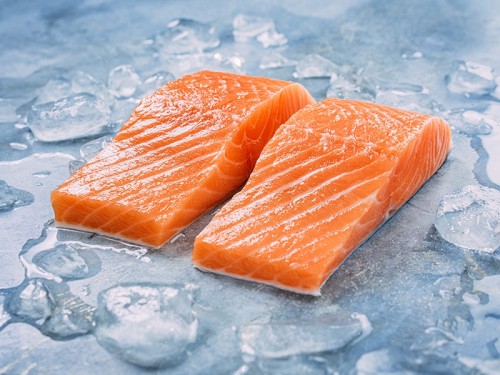In the pink – Panaferd-AX is the natural choice of pigment for salmonids

The colour pink is without doubt the symbol of salmon. This quality criteria affects consumer preferences (Parisenti et al, 2011), giving a significant added value to the products. The salmon industry has so far been quite secretive about the origin of the pigment used, when demands from customers lean towards more natural and sustainable products, free of any synthetic additives. As salmonids cannot metabolize carotenoids themselves, they need to find them in their diets. Pigments can be of two sources, however, either synthetic or natural, which is something that is, unfortunately, barely mentioned. Natural carotenoids such as Panaferd-AX provide an efficient and natural solution.

Panaferd®-AX is a healthy and natural choice for salmon and seafood
1. Sources of carotenoids
In nature, wild salmon get carotenoids from various primary producers such as micro-algae, bacteria or yeast and also from live food. In an aquaculture situation, dry feed is generally the only source of carotenoids. Various feed additives containing carotenoids such as astaxanthin are available from two major origins:
a) the synthetic astaxanthin, chemically engineered through complex reactions from crude oil-based components. This synthetic pigment only contains astaxanthin under various isomeric forms, not existing in nature. Considered as a “chemical dye” by some, synthetic astaxanthin cannot be consider as natural, nor identical to carotenoids found in wild salmon. It is therefore clearly not authorized in the EU organic aquaculture standards and tends to be less used by premium farms and even banned by some food stores.
b) natural carotenoids can be extracted from the bacterial micro-organism Paracoccus carotinifaciens, better well known under the brand name Panaferd-AX®. This has the advantage of containing various carotenoids such as astaxanthin, adonirubin, canthaxanthin and adonixanthin. The table 1 features the main specifications and differences between Panaferd-AX and synthetic astaxanthin.

Comparative table between PANAFERD-AX and synthetic astaxanthin
2. Efficacy of Panaferd-AX® for salmon
In a study conducted in Scotland (ENEOS Corporation data), the efficacy of Panaferd pigment at different standard pigment rates (40 and 70 ppm) in Atlantic salmon (Salmo salar) was compared to synthetic astaxanthin.
A stability study was also performed to evaluate the carotenoid stability of salmon fillets under freezing conditions (-25°C) over a period of six months. Atlantic salmon smolts from the same genetic strain and hatchery were raised up to market size. Pigmented diets contained astaxanthin levels at 40 or 70 either from Panaferd-AX ppm (PF1 and PF2 respectively) or synthetic form (SA1 and S2).
At the end of the trial (triplicates), no significant differences in growth, SGR and FCR were observed either during the growing period demonstrating there was no relationship between pigment source (synthetic versus Panaferd-AX) or carotenoid concentration.
Regarding the results on the flesh quality, all Panaferd®-AX groups performed very well and reached, after 17 months, a colour level on the Roche SalmoFan® (an industry-wide chart used to grade salmon colour) in accordance to the market expectations as shown in graph 1.
The test stability results at freezing temperature (-25°C) also confirm the excellent stability of carotenoids of Panaferd-AX in salmon as detailed in table 2, without any difference between natural and synthetic astaxanthin.
In the smoking process, similar results were found by Lerfall et al, in 2016 and largely confirmed by the well-known quality of the smoked Scottish salmons. As detailed in table 2, significant quantities of other carotenoids such as adonirubin in the salmon flesh are very typical of Panaferd®-AX use, while synthetic based pigment contains only one form of carotenoid.
Recent studies have proven the strong anti-oxidative, anti-tumour-promoting, and anti-carcinogenic activities of adonirubin (Maoka et al.2013). Panaferd®-AX carotenoids such as astaxanthin are present as free and same isomeric forms (3S-3’S) as wild salmon. In synthetic astaxanthin, astaxanthin is a mixture of enantiomers, not existing in nature. This difference can be used to distinguish between farmed and wild salmon through an approved method by the FDA (Turujman, 1997).

Roche Colour score after 17 month growing period
- Fresh Salmon
- Panaferd-AX is a unique natural source of carotenoids used to provide natural antioxidants, nutrients, and colour to salmon
3. Market development for natural colour
In Australia, a recent media controversy regarding salmon farming has reopened the sensitivity of the debate about salmon colour origin and transparency in labelling. Most Scottish farms such as Loch Duart have long ago switched from synthetic pigment to Panaferd-AX as a reliable source of pigment.
As fresh or smoked, the Scottish salmon ranks at the top of the list for its quality and is easily distinguished by its attractive deep pink colour. Ireland has based its development on the organic aquaculture segment led by MOWI group, with incredible results, and it has a promising future.
As synthetic pigment is banned for organic production, all organic farms use Panaferd-AX. Major Norwegian farms such as Kvarøy Arctic base their strategy on premium salmon for the US market where the demand for naturally pigmented salmon is growing fast. In Iceland, the industry well understands that it is in its interests to target added value in the premium segment by using natural pigment.
RAS farms such as Atlantic Sapphire have also well understood the advantage of being better linked to nature through the use of natural pigment.
Panaferd®- AX represents a reliable and stable pigment for salmonids. On the market side, consumer purchasing trends for more natural food, free of synthetic additives are now more prevalent. Natural pigment allows access to all markets worldwide in the premium salmon segment.
Unfortunately, in many countries opponents of aquaculture will look for any weaknesses in farming practices to stop the industry’s development. Synthetic pigment always potentially exposes our industry to negative critics. As colour is the symbol of salmon, it deserves to be natural.

Table 2: Carotenoids in the salmon flesh (mg/kg) during the test stability at freezing temperature (25C)
Author: Dominique Corlay, Eng, MSc
Aquaculture Natural Solutions, France-
Email: ansaqua.dc@gmail.com
All references available on request.
For any technical and commercial information: Arkadiusz Borowiec, Sales Manager Europe, Panaferd®-AX, Tel: +33 44 227 76 24,
Email: arkadiusz.borowiec@anciglobal.com



